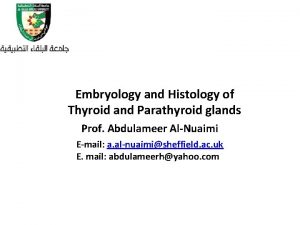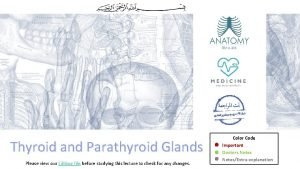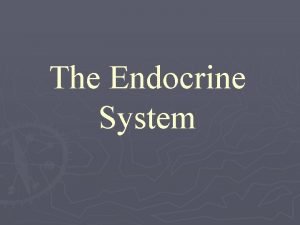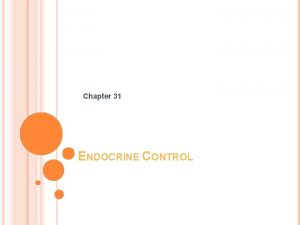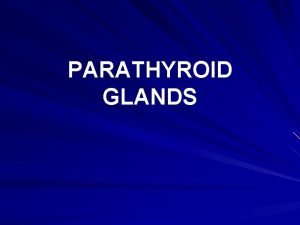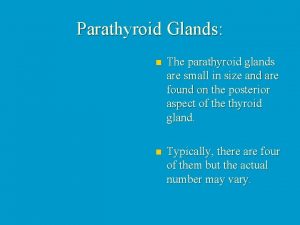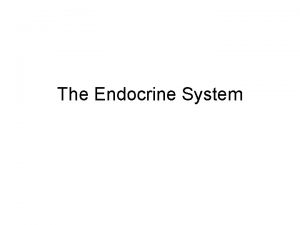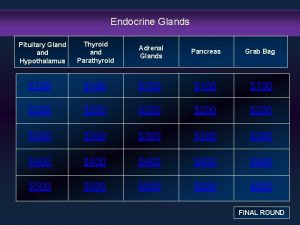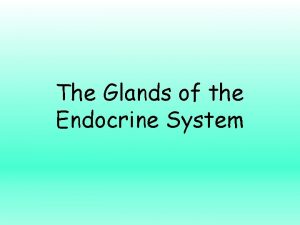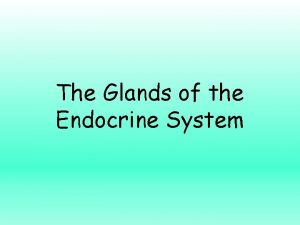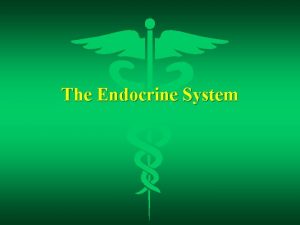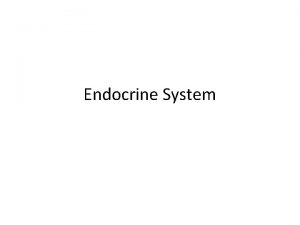The Endocrine System Parathyroid Glands Krystel Cuadra Norma










- Slides: 10

The Endocrine System: Parathyroid Glands Krystel Cuadra Norma Hamilton Vanessa Luna

p h y si c al C h e m ic al The parathyroid glands are located in the posterior surface The parathyroid glands are of the thyroid gland. The formed by glandular tissue. parathyroid glands may be within It is also composed of two the thyroid or next to it. M types of cells the oxiphil However, the thyroid and the o cells and the chief cells. parathyroid have completely l Oxiphil cells are large, few different functions. Typically, e in number and have a light there are four parathyroid glands c color when viewing a tissue. There are two parathyroid u sample of parathyroid glands on each thyroid lobe. Two l Chief cells are small, superior parathyroid and two a numerous, and have a dark inferior parathyroid. Each color. The main function of r parathyroid gland is oval shaped chief cells is to release the and it’s the size of a grain of parathyroid hormone. rice. Normal parathyroid glands are the color of spicy yellow mustard. Parathyroid glands secrete PTH (polypeptide) or parathyroid hormone which regulates calcium in the blood and in the bones. PTH is the most important regulator of calcium. When blood calcium drops PTH stimulates the release of osteclast cells or bone destructive cells to break down bone matrix and release calcium into the blood. PTH is a hypercalcemic hormone in that it increases calcium level; the opposite is calcitonin which decreases calcium levels. Calcium is the only element/mineral that has a regulatory system in the body the parathyroid glands.

Images of Parathyroid Gland Molecular image Illustration

• Actual picture of parathyroid gland during parathyroidectom y • The larger arrow points to the superior parathyroid gland. The smaller arrow points to the inferior parathyroid gland.

Function : The main function of the parathyroid glands is to regulate calcium levels within the body. • When the calc iu blood are too m level in the high, the cells of the parathy ro parathyroid ho id make less rm making it altog one (or stop e allowing calciu ther), thereby m levels to decrease. • When the c alciu low chief cells m level is too re which causes t lease PTH , he of bone to rele breakdown a into the blood se calcium. ill w n o i t func d i o r y h are rat t a a p h l t a s el regulates PTH( • Norm lcium lev a hyroid have • Tchetparat D, and n i m a t i V n ta de), cons polypepti Calcitoni

Organs Affected Calcium effects on other body systems • PTH affects bones, and the kidney • Causes release of calcium from bones • Causes calcium to be absorbed into the intestine • Prevents kidneys from excreting calcium in urine • Increases blood levels of magnesium 1. To provide the electrical energy for our nervous system is the most important function of calcium. 2. To provide the electrical energy for our muscular system 3. To provide strength to our skeletal system

Hyperparathyroidism Diseases What is Hyperparathyroidism? - It is the main disease of the parathyroid gland in which the Imbalance of hormones causes high blood calcium levels. - Excess production of parathyroid hormone (PTH) can lead to one of the four parathyroid glands becoming enlarged - This is the most common parathyroid disease in 94% of patients - This enlargement results in a benign tumor called parathyroid adenoma ( not cancerous) - Most patients with primary hyperparathyroidism have PTH levels ranging from 60 to 150 - Symptoms: • Muscle Cramps especially in the legs • Loss of Energy • Depression • High blood pressure • Thinning of the Hair • Difficulty in sleeping • Headaches -Treatment: parathyroidectomy

Osteoporosis What is Osteoporosis? - It is the loss of calcium found in the bones - the blood calcium level drops below a certain point and the bone matrix starts to break down due to osteoclasts released by PTH. - Most patients with hyperparathyroidism are likely to have osteoporosis. • This is an actual photo of a broken hip bone from a man with osteoporosis due to a parathyroid tumor Symptoms: • Joint &muscle aches • Weak bones • Fractures • Spine deformation • Causes: Loss of height 1) Excess parathyroid hormone 2) Aging 3) Lack of estrogen in older women CURE/ Treatment: In order to increase bone density, the parathyroid adenoma must be removed. Then the patient can start to take calcium pills.

What is Hypoparathyroidism? - It occurs when the parathyroid glands do not produce enough parathyroid hormones (PTH) -The most common cause of hypoparathyroidism is the loss of parathyroid tissue - The lack PTH, in turn, leads to a decrease in the blood levels of calcium - Types of Hypoparathyroidism: 1. Deficient Parathyroid Hormone (PTH) secretion. (99% of all cases) 2. Congenital Hypoparathyroidism occurs when patients are born without parathyroid tissue. (extremely rare) 3. Pseudo-hypoparathyroidism : Inability of the kidneys & bones to respond to the parathyroid Symptoms: -Muscle cramps - Pain in legs -Weakened tooth - Dry Hair -Tetany: Low blood calcium level can lead to uncontrollable spasms Treatment: Vitamin D and calcium supplements are the primary treatments ; Parathyroid Transplant is

 Thyroid and parathyroid glands
Thyroid and parathyroid glands Parathyroid gland image
Parathyroid gland image Nerve supply of thyroid gland
Nerve supply of thyroid gland Glands of the endocrine system
Glands of the endocrine system Holocrine gland
Holocrine gland Major endocrine glands male and female
Major endocrine glands male and female Chapter 16
Chapter 16 Difference between endocrine and exocrine glands
Difference between endocrine and exocrine glands Exocrine glands are ductless
Exocrine glands are ductless Oxyphil
Oxyphil Whats the difference between endocrine and exocrine glands
Whats the difference between endocrine and exocrine glands

